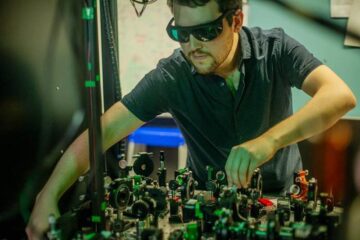ORNL new material possible boon for lithium ion batteries

A team led by Hansan Liu, Gilbert Brown and Parans Paranthaman of the Department of Energy lab's Chemical Sciences Division found that titanium dioxide creates a highly desirable material that increases surface area and features a fast charge-discharge capability for lithium ion batteries. Compared to conventional technologies, the differences in charge time and capacity are striking.
“We can charge our battery to 50 percent of full capacity in six minutes while the traditional graphite-based lithium ion battery would be just 10 percent charged at the same current,” Liu said.
Compared to commercial lithium titanate material, the ORNL compound also boasts a higher capacity – 256 vs. 165 milliampere hour per gram – and a sloping discharge voltage that is good for controlling state of charge. This characteristic combined with the fact oxide materials are extremely safe and long-lasting alternatives to commercial graphite make it well-suited for hybrid electric vehicles and other high-power applications.
The results, recently published in Advanced Materials, could also have special significance for applications in stationary energy storage systems for solar and wind power, and for smart grids. The titanium dioxide with a bronze polymorph also has the advantage of being potentially inexpensive, according to Liu.
At the heart of the breakthrough is the novel architecture of titanium dioxide, named mesoporous TiO2-B microspheres, which features channels and pores that allow for unimpeded flow of ions with a capacitor-like mechanism. Consequently, a lithium ion battery that substitutes TiO2-B for the graphite electrode charges and discharges quickly.
“Theoretical studies have uncovered that this pseudocapacitive behavior originates from the unique sites and energetics of lithium absorption and diffusion in TiO2-B structure,” the authors write in their paper, titled “Mesoporous TiO2-B Microspheres with Superior Rate Performance for Lithium Ion Batteries.”
Paranthaman noted that the microsphere shape of the material allows for traditional electrode fabrication and creates compact electrode layers. He also observed, however, that the production process of this material is complex and involves many steps, so more research remains to determine whether it is scalable.
Other authors of the paper are Zhonghe Bi, Xiao-Guang Sun, Raymond Unocic and Sheng Dai. The research was supported by DOE's Office of Science, ORNL's Laboratory Directed Research and Development program, and ORNL's SHaRE User Facility, which is sponsored by Basic Energy Sciences.
ORNL is managed by UT-Battelle for the Department of Energy's Office of Science.
NOTE TO EDITORS: You may read other press releases from Oak Ridge National Laboratory or learn more about the lab at http://www.ornl.gov/news. Additional information about ORNL is available at the sites below:
Twitter – http://twitter.com/oakridgelabnews
RSS Feeds – http://www.ornl.gov/ornlhome/rss_feeds.shtml
Flickr – http://www.flickr.com/photos/oakridgelab
YouTube – http://www.youtube.com/user/OakRidgeNationalLab
LinkedIn – http://www.linkedin.com/companies/oak-ridge-national-laboratory
Facebook – http://www.facebook.com/Oak.Ridge.National.Laboratory
Media Contact
More Information:
http://www.ornl.govAll latest news from the category: Materials Sciences
Materials management deals with the research, development, manufacturing and processing of raw and industrial materials. Key aspects here are biological and medical issues, which play an increasingly important role in this field.
innovations-report offers in-depth articles related to the development and application of materials and the structure and properties of new materials.
Newest articles

Combatting disruptive ‘noise’ in quantum communication
In a significant milestone for quantum communication technology, an experiment has demonstrated how networks can be leveraged to combat disruptive ‘noise’ in quantum communications. The international effort led by researchers…

Stretchable quantum dot display
Intrinsically stretchable quantum dot-based light-emitting diodes achieved record-breaking performance. A team of South Korean scientists led by Professor KIM Dae-Hyeong of the Center for Nanoparticle Research within the Institute for…

Internet can achieve quantum speed with light saved as sound
Researchers at the University of Copenhagen’s Niels Bohr Institute have developed a new way to create quantum memory: A small drum can store data sent with light in its sonic…





















